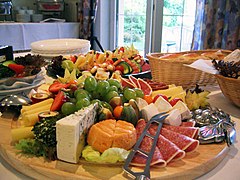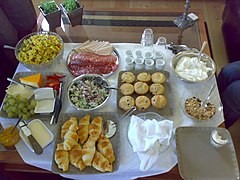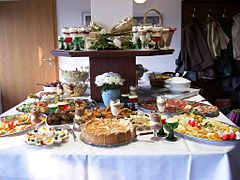Buffet
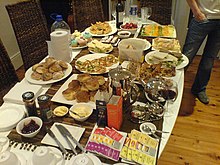
| Part of a series on |
| Meals |
|---|
 |
| Meals |
| Components andcourses |
| Related concepts |
Abuffetcan be either asideboard(a flat-topped piece of furniture with cupboards and drawers, used for storing crockery, glasses, and table linen) or a system of serving meals in which food is placed in a public area where the diners serve themselves.[1]A form ofservice à la française,buffets are offered at various places includinghotels,restaurants,and many social events. Buffet restaurants normally offer all-you-can-eat food for a set price, but some measure prices by weight or by number of dishes. Buffets usually have some or mostly hot dishes, so the termcold buffet(seeSmörgåsbord) has been developed to describe formats lacking hot food. Hot or cold buffets usually involve dishware and utensils, but afinger buffetis an array of foods that are designed to be small and easily consumed only by hand, such as cupcakes, slices of pizza, foods on cocktail sticks, etc.
The essential feature of the various buffet formats is that the diners can directly view the food and immediately select which dishes they wish to consume, and usually also can decide how much food they take. Buffets are effective for serving large numbers of people at once, and are often seen in institutional settings, business conventions, or large parties.
Home entertaining[edit]
As a buffet involves diners serving themselves, it has in the past been considered an informal form of dining, less formal than table service. In recent years, however, buffet meals are increasingly popular among hosts of home dinnerparties,especially in homes where limited space complicates the serving of individual table places.
Origins[edit]
In the 19th century,supper,a lighter meal some hours after the maindinner,was sometimes served as a buffet (and so called), especially late at night at grand balls, where not everyone present eats at the same time, or in the same quantity. Even in a very large building, at a large ball there might not be enough space to seat all guests at the same time, or servants to serve them in the manner required by the prevailing customs. A large cookedEnglish breakfastwith various choices was also very often routinely served this way, for similar reasons. Even when many servants were on hand, there might be an element ofself-service.The termbuffetoriginally referred to the Frenchsideboardfurniture where the food was placed, but eventually became applied to the serving format.
At balls, the "buffet" was also where drinks were obtained, either by circulatingfootmensupplying orders from guests, but often by the male guests. During the Victorian period, it became usual for guests to have to eat standing up. In fact John Conrade Cooke's cookbookCookery and Confectionery,(London: 1824) says it was already "the present fashion".[2]In a report on a ball in 1904, a departure from "the usual stand-up buffet supper", with parties being able to reserve tables, was praised.[3]
Scandinavians like to claim that the buffet table originates from thebrännvinsbord(Swedishschnapps,or shot of alcoholic beverage)[4]table from the middle of 16th century. This custom had its prime during the early 18th century. Thesmörgåsbordbuffet did not increase in popularity until the expansion of the railroads throughout Europe.[citation needed]
Thesmörgåsbordtable was originally a meal where guests gathered before dinner for a pre-dinner drink, and was not part of the formal dinner that followed. Thesmörgåsbordbuffet was often held in separate rooms for men and women before the dinner was served.[5]
Smörgåsbordbecame internationally known as "smorgasbord" at the1939 New York World's Fairexhibition, as the Swedes had to invent a new way of showcasing the best of Swedish food to large numbers of visitors.[citation needed]
As displays of wealth[edit]

While the possession of gold and silver has been a measure ofsolvencyof a regime, the display of it, in the form of plates and vessels, is more a political act and a gesture ofconspicuous consumption.The 16th-century French termbuffetapplied both to the display itself and to the furniture on which it was mounted, often draped with rich textiles, but more often as the century advanced the word described an elaborately carved cupboard surmounted by tiers of shelves. In England, such a buffet was called acourt cupboard.Prodigal displays of plate were probably first revived at the fashionable court ofBurgundyand adopted in France. TheBaroquedisplays of silver and gold that were affected byLouis XIV of Francewere immortalized in paintings byAlexandre-François Desportesand others, before Louis' plate and his silver furniture had to be sent to the mint to pay for the wars at the end of his reign.[citation needed]
During the 18th century, more subtle demonstrations of wealth were preferred. The buffet was revived in England and France at the end of the century, when new ideals of privacy made a modicum ofself-serviceat breakfast-time appealing, even among those who could have had afootmanservant behind each chair. InThe Cabinet Dictionaryof 1803,Thomas Sheratonpresented aneoclassicaldesign and observed, that "a buffet may, with some propriety, be restored to modern use, and prove ornamental to a modern breakfast-room, answering as the china cabinet/repository of a tea equipage."
20th century[edit]
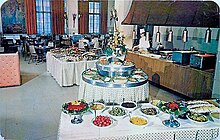
In a 1922 housekeeping book entitledHow to Prepare and Serve a Meal,Lillian B. Lansdown wrote:
The concept of eating a buffet arose in mid 17th century France, when gentleman callers would arrive at the homes of ladies they wanted to woo unexpectedly. Their surprise arrival would throw the kitchen staff into a panic and the only food that could be served was a selection of what was found in the cold room.
The informal luncheon or lunch—originally the light meal eaten between breakfast and dinner, but now often taking the place of dinner, the fashionable hour being one (or half after if cards are to follow)—is of two kinds. The "buffet" luncheon, at which the guests eat standing; and the luncheon served at small tables, at which the guests are seated...
The knife is tabooed at the "buffet" lunch, hence all the food must be such as can be eaten with fork or spoon. As a rule, friends of the hostess serve... The following dishes cover the essentials of a "buffet" luncheon. Beverages: punch, coffee, chocolate (poured from urn, or filled cups brought from pantry on tray); hot entrées of various sorts (served from chafing dish or platter) preceded by hot bouillon; cold entrées, salads, lobster, potatoes, chicken, shrimp, with heavy dressings; hot rolls, wafer-cut sandwiches (lettuce, tomato, deviled ham, etc.); small cakes, frozen creams and ices.[6]
The informal luncheon at small tables calls for service by a number of maids, hence the "buffet" plan is preferable.[citation needed]
Variations[edit]

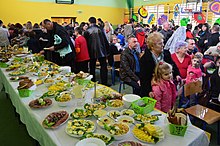
There are many different ways of offering diners a selection of foods that are called "buffet" style meals. Some buffets are "single pass only", but most buffets allow a diner to first take small samples of unfamiliar foods, and then to return for more servings if desired. To avoid misunderstandings in commercial eating establishments, the rules and charges are often posted on signs near the buffet serving tables.
- One form of buffet is to have a display counter or table filled with plates containing fixed portions of food; customers select plates containing whichever dishes they want as they walk along. The food display may either be staffed, or the customers may pick up the food plates themselves. This form is most commonly seen incafeterias.Another derivative of this type of buffet occurs where patrons choose food from a buffet style layout and then pay based on what was chosen (sometimes based on the weight of the food, or color-coded plates).
- A variation occurs in adim sumhouse, where seated patrons make their selections from wheeled carts containing different plates of food which the staff circulate through the restaurant. Another variation is aconveyor belt sushirestaurant, where seated patrons select dishes from a continuously moving conveyor belt carrying a variety of foods. In another variation, Brazilianrodíziostyle buffets feature roving waiters servingchurrascariabarbecued meats from large skewers directly onto the seated diners' plates.[7]In Brazil, therodíziostyle is sometimes also found in Italian (restaurants serving pizza are especially common), and more recently in Japanese restaurants, and also other types of foods.[8][9]
- The "all-you-can-eat" buffet is more free-form; customers pay a fixed fee and then can help themselves to as much food as they wish to eat in a single meal. This form is found often in restaurants, especially inhotels.In some countries, this format is popular for "Sundaybrunch"buffets.
- A so-calledMongolian barbecuebuffet format allows diners to collect various thinly-sliced raw foods and add flavorings, which are thenstir-friedon a large griddle by a restaurant cook.
- Somehot potrestaurants offer all-you-can-eat buffets, in which diners directly gather or order plates of thinly-sliced raw foods and flavorings, and cook them in boiling pots of soup at their tables.
- Asalad baris commonly offered indelicatessensandsupermarkets,in which customers help themselves tolettuceand othersaladingredients, then pay by weight. Sometimes only cold foods are offered, but often warmed or hot foods are available at a "hot foods bar", possibly at a different price by weight.
- Open buffets are often associated with a celebration of some sort, and there may be no explicit charge or the cost may be included in an admission fee to the entire event.Art showopenings at galleries and museums are often accompanied by a modest buffet for invited guests.
As a compromise between self-service and full table service, a staffed buffet may be offered: diners carry their own plate or tray along the buffet line and are given a portion by a server at each station, which may be selected or skipped by the diner. This method is prevalent at catered meetings where diners are not paying specifically for their meal.
Alternatively, diners may serve themselves for most prepared selections, but acarverystation for roasted meats is staffed. Some buffet formats also feature staffed stations wherecrepes,omelettes,noodle soups,barbecued meats,orsushiare custom prepared at the request of individual diners.
All-you-can-eat[edit]
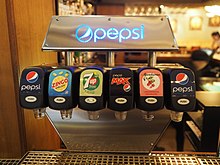
Theall-you-can-eat restaurantwas introduced inLas Vegasby Herbert "Herb" Cobb McDonald in 1946.[10][11]The buffet was advertised in flyers for only one dollar, and a patron could eat, "every possible variety of hot and cold entrees to appease the howling coyote in your innards".[11]
Manyboarding schools,colleges, and universities offer optional or mandatory "meal plans", especially in connection withdormitoriesfor students. These are often in an "all-you-can-eat" buffet format, sometimes called "all-you-care-to-eat" to encouragedietary moderation.[12][13]The format may also be used in other institutional settings, such asmilitary bases,large factories,cruise ships,ormedium-securityprisons.
In 2007, the firstall-you-can-eat seating sectioninMajor League Baseballwas introduced atDodger Stadium.[14]The trend spread to 19 of the 30 major league parks by 2010,[15]and numerous minor league parks by 2012.[16]The basic menu includes traditional ballpark food such ashot dogs,nachos,peanuts,popcorn,andsoft drinks.[17][18]In 2008, all-you-can-eat seats were also inaugurated in numerousNBAandNHLarenas.[19]
Some buffet restaurants aim to reduce food waste, by imposing fines on customers who take large amounts of food, but then discard it uneaten.[20]
Restaurant buffets[edit]

In Australia, buffet chains such asSizzlerserve a large number of patrons with carvery meats, seafood, salads and desserts. Cruise operators in Sydney, conduct Sydney Harbour sightseeing cruises with continental buffets having multiple seafood options. Buffets are also common inReturned and Services League of Australia(RSL) clubs and some motel restaurants.
In Brazil,comida a quiloorcomida por quilo—literally, "food by [the] kilo" —restaurants are common. This is a cafeteria style buffet in which diners are billed by the weight of the food selected, excluding thetare weightof the plate.Brazilian cuisine'srodíziostyle is all-you-can-eat, having both non-self-service and self-service variations.
In Hong Kong, thecha chaan teng buffetis a relatively new variation on traditional low-cost Chinese snack and coffee shops.
In Japan, a buffet or smorgasbord is known as aviking(バイキング -baikingu). It is said that this originated from the restaurant "Imperial Viking" in theImperial Hotel, Tokyo,which was the first restaurant in Japan to serve buffet-style meals. Dessert Vikings are very popular in Japan, where one can eat from a buffet full of desserts.
In Sweden, a traditional form of buffet is thesmörgåsbord,which literally means "table of sandwiches".
United States[edit]

In the United States, there are numerousChinese-American cuisine-inspired buffet restaurants, as well as those serving primarily traditional American fare.[21]Also,South Asian cuisine(notably inIndian restaurants),pan-Asian cuisine,andMediterranean cuisineare increasingly available in the buffet format,[22]andsushihas also become more popular at buffets.[21][22]In some regions of the US, Brazilian-stylechurrascariabarbecue buffets servedrodíziostyle are becoming popular.[7]
Las VegasandAtlantic Cityare famous for all-you-can-eat buffets with a very wide range of foods on offer, and similar ones have also become common incasinoselsewhere in the United States.[13][23]
For 2019, buffet food sales in the US were estimated at $5 billion, approximately 1% of the total restaurant business that year.[11][24]
Gallery[edit]
-
Ham and cheese in a German breakfast buffet
-
Staffed hot buffet line aboard theCelebrity Equinoxcruise ship
-
Breakfast buffet
-
Brunch buffet
-
Cheese, coldcuts, and bread station in brunch buffet
-
A platter oflunch meatand cheeses in Slovenia
-
German-style dinner buffet
-
Customer getting food from a buffet
-
Prasmanan,Indonesian-style buffet
See also[edit]
References[edit]
- ^"Buffet".The Free Dictionary By Farlex.Retrieved19 May2012.
- ^Day, Ivan,"Pride and Prejudice - Having a Ball",Food Jottings
- ^"Everyone present at the ball appreciated, however, the supper arrangements, which permitted of small tables being engaged for one's party instead of the usual stand-up buffet supper",The Sphere: An Illustrated Newspaper for the Home,Volume 18, 1904
- ^"Christmas Celebrations Etiquette"[permanent dead link](Swedish).Etikett Doktorn.Accessed June 2011.
- ^sv:brännvinsbord "Brandy Bordet"(Swedish Wikipedia article). Accessed June 2011.[circular reference]
- ^How to Prepare and Serve a Meal,Project Gutenberg etext of the 1922 book by Lillian B. Lansdown
- ^abTonon, Rafael (6 October 2016)."How the Brazilian Steakhouse Chain Fogo de Chão Swept America".Eater.Vox Media Inc.Retrieved4 April2019.
- ^"Depois viagem internacional, casal decide investir rodízio de crepes, prato de origem francesa".G1(in Brazilian Portuguese). 23 April 2023.Retrieved5 November2023.
- ^"Melhores rodízios em São Paulo para se esbaldar de comer".quantocustaviajar(in Brazilian Portuguese). 13 September 2023.Retrieved5 November2023.
- ^"Strip visionary McDonald dies".Las Vegas Sun.9 July 2002.
- ^abc"Coronavirus: The slow death of the American all-you-can-eat buffet".BBC News.
- ^Lam, Bourree."All You Can Eatonomics".Lucky Peach.Archived fromthe originalon 13 April 2015.Retrieved14 April2015.
- ^abTiffany, Kaitlyn (3 April 2019)."When did America's heart turn cold on buffet chains?".Vox.Vox Media Inc.Retrieved4 April2019.
- ^"Dodger Stadium's All-You-Can-Eat Seats Are a Popular Draw".The New York Times.Associated Press. 27 May 2007.Retrieved9 July2014.
- ^"Growing Trend: All-you-can-eat sections at big-league parks".Sports Illustrated.20 July 2010.Retrieved14 July2014.
- ^Williams, Doug (11 June 2012)."All-you-can-eat sections sweep baseball".ESPN.Retrieved9 July2012.
- ^McCarthy, Michael (7 March 2008)."Eating Away the Innings in Baseball's Cheap Seats".USA Today.Retrieved17 July2014.
- ^Carman, Tim (1 May 2012)."Where the empty calories just keep on coming".The Washington Post.Retrieved15 July2014.
- ^"Baseball Fans Get Never-Ending Ballpark Buffet, Much to the Dismay of Nutritionists".Fox News.Associated Press. 21 March 2008. Archived fromthe originalon 11 August 2014.Retrieved20 July2014.
- ^Paavola, Laura (27 March 2024)."Vantaan ensimmäinen aito teppanyaki-ravintola otti heti kovat keinot käyttöön: Sakottaa asiakkaita pois heitetystä ruoasta".City(in Finnish).Retrieved30 April2024.
- ^abNewman, Jacqueline M."Chinese Buffets: A Trend Worth Exploring".Flavor & Fortune.ISACC. Archived fromthe originalon 26 October 2013.Retrieved1 June2014.
- ^abFilloon, Whitney (15 October 2018)."How to Get Your Money's Worth at All-You-Can-Eat Buffets".Eater.Vox Media Inc.Retrieved4 April2019.
- ^"Buffetmovie".Buffetmovie.Retrieved24 September2013.
- ^Kang, Jaewon; Haddon, Heather (7 July 2020)."Buffets and Salad Bars, Closed by the Pandemic, Remain Roped Off".Wall Street Journal.Retrieved20 September2022.
Further reading[edit]
- Peck, Carole (1997).The Buffet Book: Inspired Ideas for New-Style Entertaining, with 175 Recipes.Viking.ISBN0-670-86516-8.
- "Novel Touches for Buffet Service".Popular Mechanics.Hearst Magazines. August 1945. pp. 89–90.Retrieved26 August2020.
- Von Welanetz Wentworth, Diana; Paul Von Welanetz (1978).The Art of Buffet Entertaining.Los Angeles: J. P. Tarcher.ISBN0-87477-080-7.

